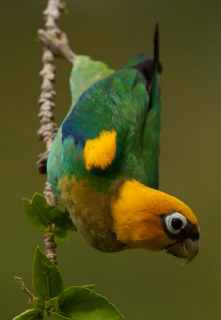Saffron-headed Parrot |
|
|
Also known as: Bonaparte's Parrot
Photos
View in GalleryDid You Know?
The Pyrilia group differs from other parrot groups by the less-prominent bill, narrower, pointy wings (like a falcon), and longer and narrower tail feathers.Academic Research
Related publications: Pyrilia pyriliaSpecies Profile
Genus: Pyrilia | Species: pyrilia
Size:
24cm (9.3 in)
Weight:
103g (3.6 oz)
Subspecies including nominate:
one
Colour Adult:
Both adults in general green, yellow all over head and throat; neck and upper breast olive; a few yellow and red feathers on thighs; yellow lesser wing coverts, bases of the feathers red; bend of wing, carpal edge, underwing coverts, axillary feathers and sides of underparts red; tail green tipped with blue. Bill horn in colour. Eye ring white, eye dark brown.
Colour Juvenile:
Head green instead of yellow; cheeks and ear coverts tinged with olive; throat and upper breast olive; green lesser wing coverts and carpal edge, with a few red feathers in carpal area; lesser underwing coverts red; green greater underwing coverts.
Call:
Calls described as scraping sounds and high-pitched notes.
Video Links:
Video 1More Information:
Content Sources:
CITES
Birdlife International
Cornell Lab of Ornithology/Birds of the World
Parrots: A Guide to Parrots of the World, Juniper and Parr, 1998
Parrots of the World, Forshaw, 2006. 2010 edition
Parrots: Their Care and Breeding, Low, 1986.
Lexicon of Parrots, Thomas Arndt.
Photos
View in GalleryDid You Know?
The Pyrilia group differs from other parrot groups by the less-prominent bill, narrower, pointy wings (like a falcon), and longer and narrower tail feathers.Academic Research
Related publications: Pyrilia pyriliaSpecies Care
Captive Status:
Very uncommon
Longevity:
Not recorded.
Housing:
Indoor enclosure 3 x 2 x 2m (9.8 x 6.5 x 6.5 ft) with roosting box 25cm x 25cm x 60cm (10" x 10" x 24") .
Diet:
Fruits such as: apple, orange, cactus fruits, pomeganate; vegetables such as: carrot, celery, green beans and peas in the pod, corn; commercial lory food or porridge; seed mix such as: millet, canary, safflower, oats, canary grass seed, limited sunflower; sprouted beans or other pulses; vitamin supplements especially C; complete kibble if taken.
Enrichment:
Provide fresh bird-safe branches, shallow bowls for bathing.
Nest Box Size:
25 x 25 x 60cm (10" x 10" x 24") vertical box
Clutch Size:
Not recorded.
Incubation Time:
Not recorded.
Fledging Age:
Not recorded.
Hatch Weight:
Not recorded.
Peak Weight:
Not recorded.
Weaning Weight:
Not recorded.
Photos
View in GalleryDid You Know?
The Pyrilia group differs from other parrot groups by the less-prominent bill, narrower, pointy wings (like a falcon), and longer and narrower tail feathers.Academic Research
Related publications: Pyrilia pyriliaSpecies Wild Status
World Population:
About 7000, decreasing.
IUCN Red List Status:
Near Threatened
CITES Listing:
Appendix II
Threat Summary:
Not globally threatened. Apparently uncommon over much of its range and never very numerous; apparently now gone from C Andes and from near Bogotá. Affected by considerable habitat loss for the last four centuries, but most markedly in the 20th century. In Colombia some are captured for the bird trade. May also be affected by river and stream pollution due to mining and cocaine production.
Range:
E Panama and NW Colombia to W Venezuela, in Sierra de Perija, Zulia; possibly isolated in NW Ecuador.
Habitat:
Found in humid or wet lowland to lower montane forest, including forest margins and tall secondary growth areas. From 150-1700m (492-5576 ft).
Wild Diet:
Not known, but presumably like that of other Pyrilia sp.: seeds, fruit and possibly wasp larvae.
Ecology and Behaviour:
Probably resident with little or no regional movement. Found in small groups flying through treetops or lower calling loudly. Not easily seen while feeding quietly or resting in canopy.
Clutch and Egg Size:
Not recorded.
Breeding Season:
Breeding condition birds recorded from March-June.
Related Links:
Photos
View in GalleryDid You Know?
The Pyrilia group differs from other parrot groups by the less-prominent bill, narrower, pointy wings (like a falcon), and longer and narrower tail feathers.Academic Research
Related publications: Pyrilia pyriliaMembers Only Resources
Please log-in now to find more research, resources and tools.
Not a Member?
Find more great information:
Gain exclusive access to 600+ pages of additional research, seminars and podcasts, specialists to ask your toughest questions, and dozens of other fun resources - when you become a WPT member.
Join Today >>

































